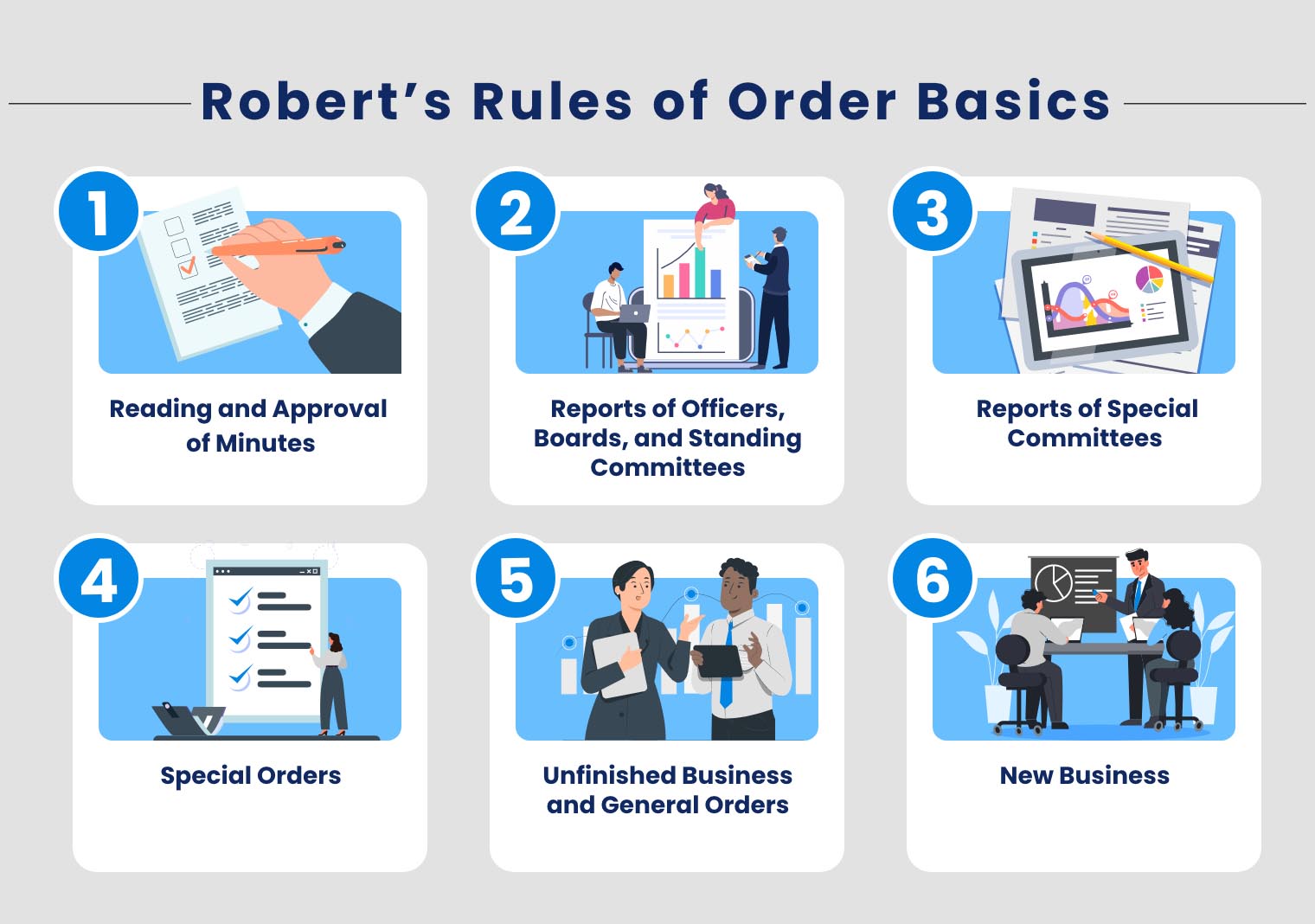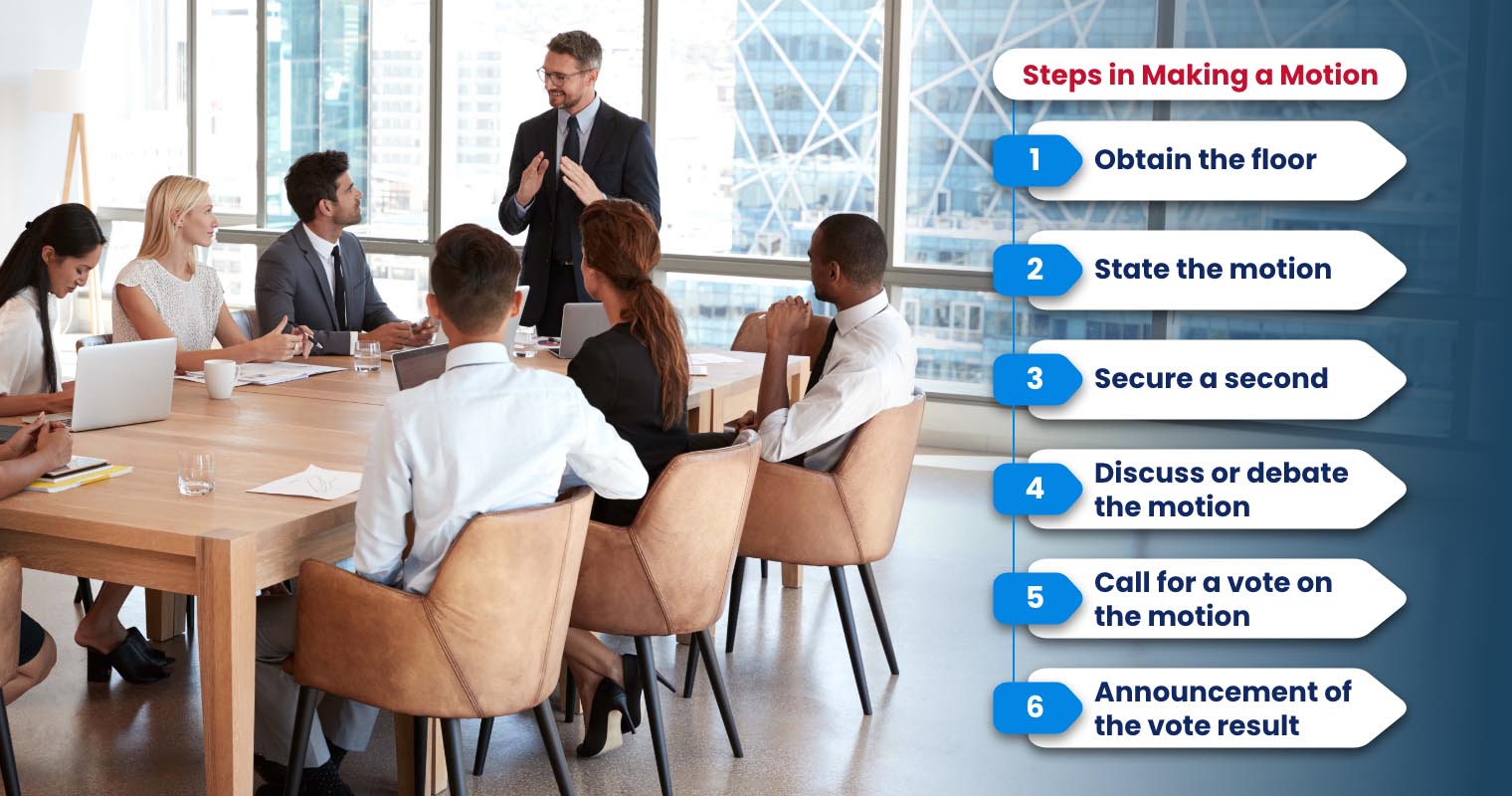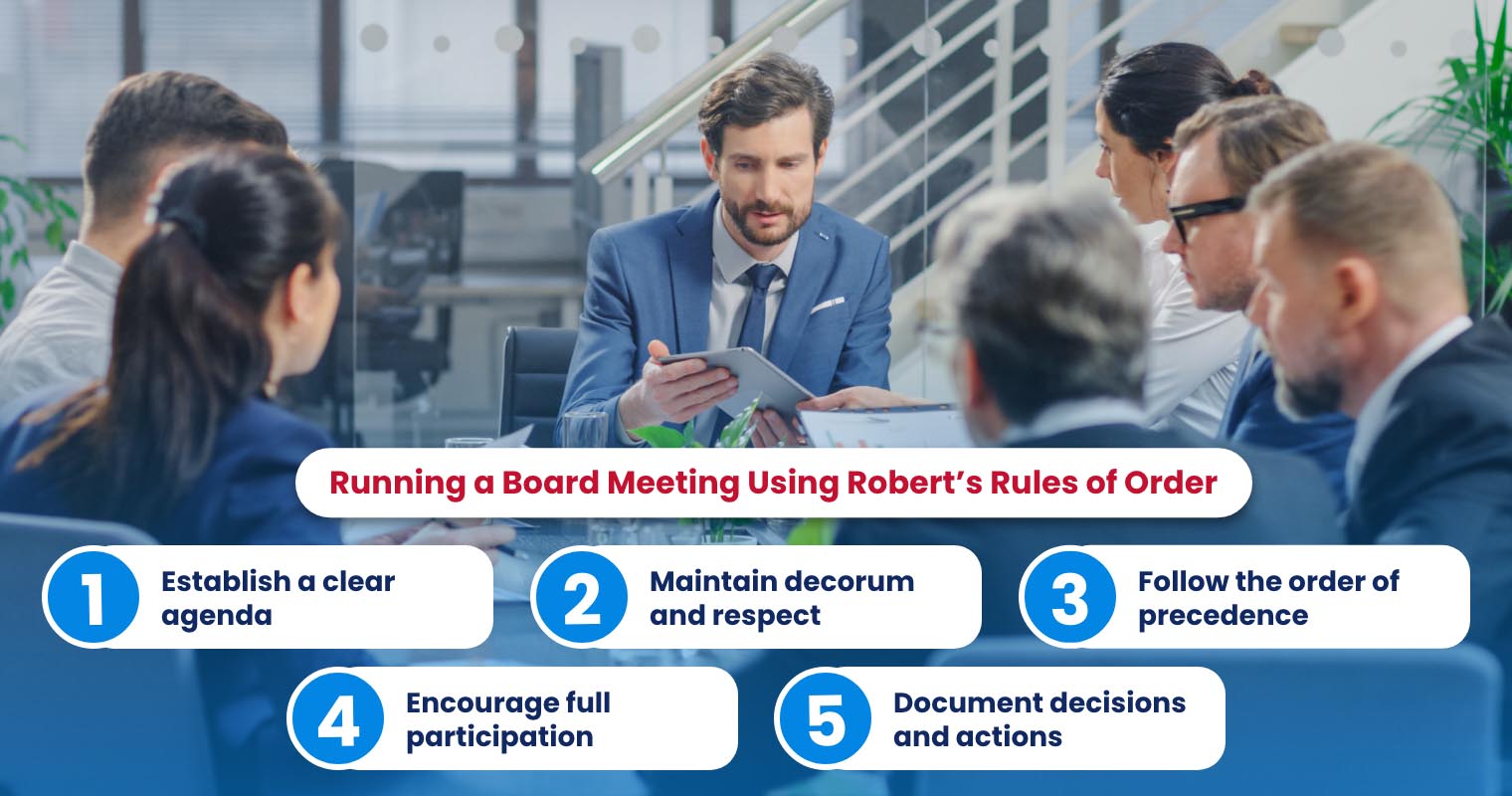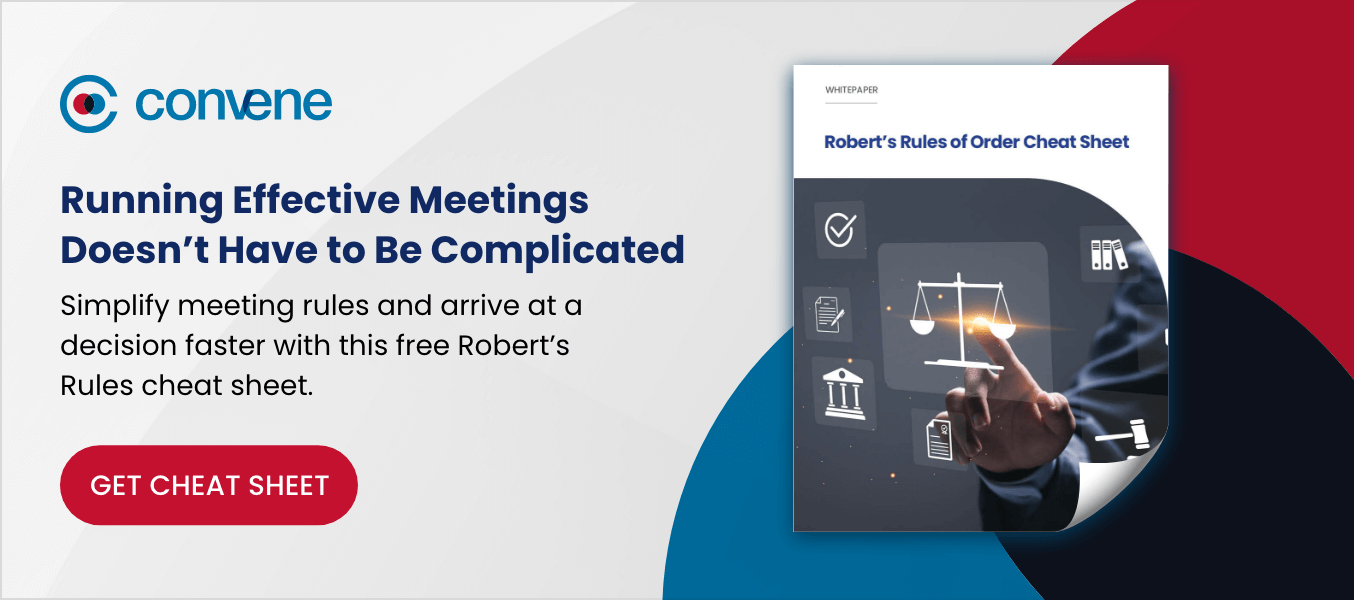In the intricate world of parliamentary procedures, Robert’s Rules of Order stands as a guiding light, offering clarity amid potential chaos. Such rules not only aim to standardize parliamentary practices but also ensure all decisions made are firm and harmonious.
With a goal to offer equal opportunities for all voices to be heard, Robert’s Rules of Order underscores the essence of majority decisions coupled with thoughtful debate — steering assemblies away from the pitfalls of pseudoconsensus.
Learn more about it in this Robert’s Rules of Order cheat sheet, and how to run board meetings using these rules.
What is Robert’s Rules of Order?
Robert’s Rules of Order stands as the quintessential manual of ethical codes guiding discussions and decisions in non-legislative organizations, notably those with boards of directors and committees. Often referred to simply as Robert’s Rules, this framework ensures systematic, orderly, and purpose-driven meetings.
Rooted in democratic principles, these rules provide a structured order where majority decisions and minority voices are equally valued. Under Robert’s Rules, all meeting participants can express their views in an equitable and structured way.
In 2020, a newly revised Robert’s Rules of Order was released, marking its 12th edition. Among the notable changes are new provisions regarding debates on nominations, and improvement on the clarity and accessibility of the rules. For the complete list of changes, refer here.
When are the rules used?
Robert’s Rules of Order for meetings are utilized in various settings, including nonprofit boards, committees, and established groups, as a parliamentary guide. By providing a standardized approach to meeting discussions, a group can reach a consensus while deliberations remain fair and organized.
What are its key principles?
The key principles of Robert’s Rules of Order for meetings are as follows:
- All members have equal rights, privileges, and obligations.
- A quorum must be present for business to be conducted.
- During a debate, personal remarks are out of order.
- Only one question at a time may be considered, and only one person may have the floor at any one time.
- Members must be informed of the pending question and have it restarted before a vote is taken.
- Full and free discussion of every main motion is a basic right.
- A majority decides a question except when the basic rights of members are involved or a rule provides otherwise.
- A 2/3 vote is required for any motion that deprives a member of rights in any way.
- Silence gives consent. Those who do not vote allow the decision to be made by those who do vote.
- The Chair should always remain impartial.
Robert’s Rules of Order Basics
Understanding Robert’s Rules of Order basics is imperative for all board members, including newly appointed ones. Learn about the basics below:

Order of Business for Meetings
The order of business for meetings may vary based on the organization’s needs and bylaws. Robert’s Rules of Order for board meetings recommends following a structured sequence.
After the meeting is called to order, it can then proceed with the following order of business:
1. Reading and Approval of Minutes
An actual reading of the minutes of each previous meeting is required. In cases, wherein minutes are already distributed to members in advance, the actual reading is only done when a member requests it. Any proposed corrections must be disposed of prior to approval of the secretary’s draft.
2. Reports of Officers, Boards, and Standing Committees
Generally, all officers, boards, and standing committees are called to report. Recommendations can be given during the reporting. However, an officer making a recommendation will not be allowed to move its implementation. Instead, another member is called to do so. As for a committee report, the chairman or other reporting members will move the implementation of any recommendations.
3. Reports of Special Committees
Reports from special committees are heard in the order of their appointment. Only committees, who are instructed and prepared to report on matters referred to them, are called upon.
4. Special Orders
Unfinished special orders from the previous meeting are addressed during this part of the meeting. Any matters required by the bylaws (e.g. nomination and election of officers) will also be considered. These are then followed by items made special orders for the current meeting. The chair announces these items as pending questions.
5. Unfinished Business and General Orders
This heading includes pending questions from the previous meeting, unfinished business not previously addressed, general orders from the last meeting, and matters postponed or made general orders for the current meeting. These items are taken up in their designated sequence.
6. New Business
Lastly, the chairman will call for any new business. Members have the right to introduce new items of business or move items from the table. Members can do so in the order they are recognized by the chair.
Optional headings in the order of business may include:
- Opening Ceremonies or Exercises: This involves rituals or activities at the start of the meeting, such as an invocation, the national anthem, or a brief recall of the organization’s objectives.
- Roll Call: Officers or members are called in roll call for attendance verification, usually done at the end of opening ceremonies.
- Consent Calendar: Routine or noncontroversial matters are listed here for efficient approval. These items are considered in sequence unless objected to by a member, in which case they return to the regular agenda.
After new business, additional optional headings may include:
- Good of the Order, General Good and Welfare, or Open Forum: Members can offer informal observations regarding the organization’s welfare, and certain announcements or resolutions related to disciplinary procedures can be discussed under this heading.
- Program: Cultural, educational, or civic programs can be presented. The program can be placed at the end of the order of business or at an unscheduled point, with the consent of the assembly.
Making a Motion: Types of Motions and Motion Steps
In the context of parliamentary procedure, a motion is a formal proposal or a discussion point made during a meeting. Each motion must be resolved or disposed of by being: passed, tabled, defeated, or referred to committee.
Types of Motions
Robert’s Rules of Order for meetings provides four types of motions, which include:
1. Main motions — Also called a principal motion, this type refers to a motion made before the assembly, for its consideration, on a specific subject. Main motions cannot be made when other motions are before the group.
2. Subsidiary motions — These motions can alter or affect how the main motion is handled. Options for the subsidiary motions are:
- To postpone indefinitely or “kill” a motion
- To amend the main motion before voting on it
- To refer the main motion or any pending subsidiary motions to a committee
- To limit or extend limits of debate
- To stop the debate and vote now
- To adopt the motion to lay on the table, halting the discussion until a majority vote is reached.
3. Incidental motions — Used as housekeeping motions, they take precedence over main or subsidiary motions and any pending questions. Some of the motions include:
- Point of order (bringing forth that the rules are violated)
- Appeal the decision of the chair
- Request to withdraw a motion
- Suspension of the rules
4. Privileged motions — These motions are usually of great importance or urgency, which requires them to be disposed of before resuming the discussion. They often deal with questions of procedure and arise out of other actions of the assembly. Examples of these motions are:
- Call for the orders of the day: Requires the assembly to conform to the order of business or the agenda.
- Raise a question of privilege: Permits a request relating to the assembly’s rights and privileges.
- Recess: Request a short intermission. Length of the recess is amendable.
- Adjourn: End the meeting immediately. This is not amendable and not debatable.
Steps in Making a Motion
Besides motion types, board members are also expected to familiarize themselves with procedures for making motions. Here are the steps in making a motion, according to Robert’s Rules of Order for meetings:

1. Obtain the floor
- Members must be recognized by the Chair. Once recognized, the member has the floor
2. State the motion
- State the motion in a clear and concise manner.
- The member will say, “I move that…”, to introduce the motion
3. Secure a second
- The motion often requires a second.
- If there is none, the motion can be deemed as lost.
4. Discuss or debate the motion
- Once the motion is presented, members are allowed to debate and address the chair.
5. Call for a vote on the motion
- Voting method on any motion may depend on the organization’s by-laws.
- Among the commonly used methods to vote are: by voice, by roll call, by general consent, by division, and by ballot.
6. Announcement of the vote result
- The result of the voting will be announced, whether the motion is adopted or defeated.
- Considered to be the assembly’s decision, further actions may be taken based on this.
Rules of Debate
While all board members have the right to discuss or debate any motion, certain meeting rules of order must be followed. The following rules are also based on Robert’s Rules’ key principles.
- A member must not speak while seated. He/she must first obtain the floor and be recognized by the chair prior to talking.
- The debate should be relevant to the motion.
- Each member may speak for no longer than ten minutes at a time, but shall not speak more than twice on the same day to the same question.
- Members are not allowed to give their time to another member during deliberative assemblies.
- All remarks must be addressed to the chair; cross-debate is not allowed.
- Members are not permitted to speak against one’s motion but can vote against it.
- Personal attacks or questions on other speakers’ motives are not permissible.
- The preceding officer should remain impartial. If the preceding officer wishes to speak on an issue, the chair must be relinquished to another officer who does not wish to speak.
- The chair must let the floor alternate between members who are speaking in support and those in opposition to the motion.
Rules of debate can be changed by a two-thirds vote.
Methods of Amending
Amendments, a vital aspect of parliamentary procedure, are used to refine motions by precisely altering their wording. These include inserting, deleting, or substituting the motion’s words or paragraphs. Here are some methods of amending motions that boards should know:
- Amend by Addition — A member can propose to insert words, phrases, or paragraphs into the motion. If approved, the additional language becomes part of the motion.
- Amend by Striking Out — This involves striking out specific words or paragraphs from the motion. If approved, the struck-out portions are removed from the motion.
- Amend by Substitution — This amendment involves striking out an entire section or paragraph (or a whole motion) and inserting a different paragraph. An approved substitution means the original motion is entirely replaced with a new one.
- Amend by Division — This is where a motion or a question upon a debate is divided into two or more questions. This is often done when a motion covers multiple issues or contains several parts, allowing each issue to be voted on separately.
- Commit or Refer to a Committee — Instead of amending the motion directly, the assembly can send it to a committee for careful investigation. The committee may then amend the motion and report back to the assembly.
- Postpone Definitely — The assembly can vote to postpone the motion to a specific future meeting or date. During this time, amendments can be made before the motion is brought back for consideration.
- Postpone Indefinitely — The assembly can vote to postpone the motion indefinitely. This essentially kills the motion without a direct vote on its merits. However, this does not prevent a similar motion from being reintroduced in the future.
- Amend the Rules — In some cases, the assembly may need to temporarily suspend or amend certain rules to allow a specific type of amendment. This requires a two-thirds vote unless specific rules state otherwise.
How to Run a Board Meeting Using Robert’s Rules of Order

In order to have effective discussions, a board meeting must be well-structured. One way to do so is by utilizing Robert’s Rules of Order for board meetings. Besides the recommendations above, here are other best practices to take note of:
1. Establish a clear agenda
Every successful board meeting is backed up by a clear agenda. In Robert’s Rules, each agenda item must be precisely defined or specific, preventing confusion among the assembly. At the same time, the meeting agenda should also be distributed to all members in advance — ensuring everyone is informed of discussion points.
2. Maintain decorum and respect
Robert’s Rules of Order for board meetings also stresses the importance of maintaining decorum and adhering to board meeting protocols. In upholding decorum, the chair must be impartial in order to keep the discussions fair and focused. Members, on the other hand, are expected to address the chair and adhere to the recognized rules of courtesy.
3. Follow the order of precedence
Another best practice is following the order of precedence for motions and discussions. Boards can ensure a more structured decision-making process by:
- strictly following this established hierarchy
- beginning with privileged motions like adjournment or recess
- addressing subsidiary motions such as amendments
Following the order of precedence ensures motions are considered in a fair, systematic manner.
4. Encourage full participation
Robert’s Rules underscores the rights of all members to express opinions and engage in debates. That said, the chair should actively encourage participation and give each member the opportunity to voice their views. The board meeting rules also suggest methods for members to gain recognition, such as raising a hand or seeking permission to speak.
5. Document decisions and actions
Accurate record-keeping is pivotal in any board meeting. Robert’s Rules of Order provides detailed guidelines on the secretary’s duties, emphasizing precise recording of meeting minutes. These minutes function as the official record of the meeting’s proceedings and decisions. Doing so enables boards to uphold the integrity of their proceedings and foster a culture of adherence to parliamentary principles.
Frequently Asked Questions About Robert’s Rules of Order
Here are some FAQs to help you learn more about Robert’s Rules of Order and its utilization.
Are Roberts Rules of Order mandatory?
No, Robert’s Rules of Order are not mandatory. Organizations and groups can choose whether to adopt these board meeting rules in their bylaws or governing documents or not. The decision may also depend on the consensus of the assembly members.
Can Robert’s Rules of Order be used in informal settings?
Yes, Robert’s Rules of Order can be applied in informal settings such as community groups, or clubs, provided all participants agree to use these rules. In such cases, the level of formality can be adjusted to suit the specific needs of the group. The key is consensus among participants to adhere to the rules and principles outlined.
Is it possible to appeal a decision made using Robert’s Rules of Order?
Yes, members can appeal a decision made using these board meeting rules. An appeal allows members to challenge a ruling or decision made by the chair or the assembly. You can utilize motions like “appeal the decision of the chair” or “division of the assembly”. The assembly then votes to uphold or overturn the decision in question.
Can Robert’s Rules of Order be modified or customized by an organization?
Yes, organizations have the flexibility to modify the meeting rules of order to better suit their specific needs. While the basic principles should be respected, organizations can add, amend, or remove rules according to their requirements.
Convene: Your Solution to Simplified and Structured Board Meetings

Conducting structured board meetings comes with the responsibility of respecting certain rules. Robert’s Rules of Order then necessitates order and fairness in such procedures and decision-making processes — ensuring organizations function efficiently.
To help establish systematic meetings while following meeting rules of order, Convene offers a secure platform specifically designed for conducting compliant, organized meetings. From creating focused agendas to conducting fair voting and resolution proceedings, Convene has the right features to make it happen.
Have access to Convene’s dedicated Agenda Builder, Document Library, and more. Reach out to our team and book a demo now!
Jielynne is a Content Marketing Writer at Convene. With over six years of professional writing experience, she has worked with several SEO and digital marketing agencies, both local and international. She strives in crafting clear marketing copies and creative content for various platforms of Convene, such as the website and social media. Jielynne displays a decided lack of knowledge about football and calculus, but proudly aces in literary arts and corporate governance.











